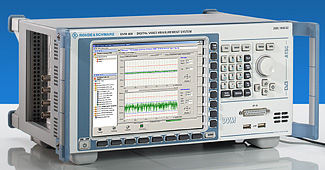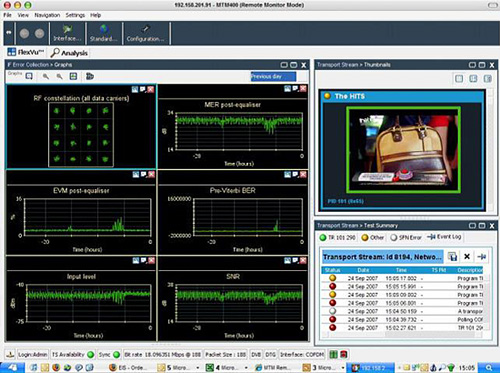DTV Begets New Transmission Test Gear
NEW YORK
When there's a problem on a local digital TV station as viewed on cable, satellite, or via IPTV, where does the fault lie? Is the TV feed to the distributor faulty? Is there something in the way the distributor aggregates the signals that causes problems such as blockiness, freeze frames, blackouts, loss of video or audio, lip sync errors, or incorrect language? When a viewer calls up to complain to the TV station, how can the engineers there trace the problem? If there's a service agreement in place between the station and the distributor, how can performance and signal quality be verified?
There are a number of tools and test methodologies that makers of test and measurement equipment offer.

The Rhode & Schwarz DVM100 transport stream monitor'IT LOOKS GOOD LEAVING HERE'
A station should first ensure that the signal is fine leaving there. And that means checking the ASI feed to the transmitter and then the 8-VSB signal through an off-air receiver, since many cable and other distribution systems take feeds from local stations off-air.
"Make sure you have a good RF signal," said Dennis Kucera, an MPEG applications engineer with Tektronix. "If you don't have an adequate amount of power, you can lose bits and experience transmission problems."
Kucera said the next check should be for transport error flags. "Make sure the signal has high integrity."
Once station personnel are assured that a good signal is leaving the TV station, then it's time to find out what the distributors might be doing to it.
According to Danny Wilson, president and CEO of Pixelmetrix, to alleviate a bandwidth crunch, service providers "will compress the signal to get in more channels, but the more compression, the greater the chance that a channel will fail."
An easy way to monitor the distributor's feed is to subscribe to that service and look at the output from a set-top box, unless arrangements can be made with the distributor to install monitoring equipment at their head end.
Today, MPEG monitoring equipment is available from several manufacturers, offering a wide range of inputs to accommodate off-air, cable, satellite and IP transmissions.
Looking at the parameters of the transport stream can indicate whether video/audio artifacts are likely to occur.
"Extract TR 101 290 transport stream parameters, and check for any continuity counter errors," Kucera said. "The continuity counter is part of the MPEG packet. It's a number that ramps from zero to 15 and repeats. If an analyzer sees a number out of sequence, it indicates missing packets, and if a packet is dropped, you can see a video artifact."
Program clock reference and jitter are some other parameters to monitor.
Bit-rate measurements, according to Bob Ellis, broadcast test and measurement product manager at Rohde & Schwarz, "are the most useful of any of the transport stream measurements."
Since most cable companies use 256-QAM at about 38 Mbps, "they pair up off-air signals and take them through a re-multiplexer of their choosing which time division multiplexes the two feeds," Kucera said. Audio and video can go through this process relatively unscathed, but "the more important issue is when they re-multiplex the program guides. Some packets and tables can collide," he said. So ensuring that the EPGs meet appropriate standards is another important test, as is checking for proper PSIP tables.
TRANSPORT STREAM ANALYSIS

MPEG RF as viewed on the Tektronix MTM400A transport stream monitor
For transport stream monitoring, a TV station has many good choices, including units for remote monitoring. Many of the remote units can be tied into SNMP systems and be monitored via a Web browser.
Often problems are intermittent.
"That's why it's important to have templates to compare test results against the desired performance specifications," said Jon Hammarstrom, senior manager of worldwide field marketing at Tektronix. "The user can set alarms or raise flags if conditions exist that might cause artifacts, and trigger the recording of the streams when something is out of tolerance."
Here's a sampling of available transport stream monitors:
Triveni Digital has added DTV carriage auditing to its StreamScope RM-40, to provide proof that service agreements are being met. The RM-40, a remote monitoring device, looks at the transport stream and captures characteristics of each stream it's monitoring.
"It does an intelligent form of averaging and looks at the average and instantaneous bandwidth of each stream," said Rich Chernock, chief technology officer for Triveni Digital. "If there's transcoding or bit-rate reduction, the instantaneous MPEG bit rate changes frame by frame."
The Tektronix MTM400A provides remote real-time transport stream monitoring and offers thumbnail and electronic program guide views, with options for deep diagnostics. The Tektronix MTX100B recorder can be triggered from the monitor to record problem signals that can be analyzed in more detail later.
Pixelmetrix offers the DVProbe remote transport stream system verification tool and the DVStation family of transport stream monitors and analyzers including stream recorders.
The Rohde & Schwarz DVM100 and DVM400 can simultaneously monitor up to four transport streams, and with the DVM120 expansion unit, up to 20 transport streams and 16 RF streams (18 RF streams for the DVM400).
The DVM400 can also be outfitted with an IP input.
According to Ellis, the units can be scheduled to monitor particular inputs for specific periods of time. "Even if one channel is selected, all other channels are monitored and logged," he said.
"You can retrieve error logs and save them on a computer or any network device and sort on what type of error occurred." The Rohde & Schwarz instrument also provides stream recording.
OTHER FORMS OF MONITORING
The Harris TVM-950-EJ with ASI option provides jitter measurements for both SDI and ASI signals, as well as waveform, vector, gamut, audio, picture, timing, data analysis and picture thumbnails.
"The frequency spectrum display of jitter is more useful than a raw jitter number or waveform," said Paul Keller, product manager for test and measurements at Harris Corp. "That way it's easy to see if [such factors as] a noisy clock or periodic frequency from a power supply is causing the jitter."
For portable ASI monitoring, Harris offers the handheld ASI-STAR transport stream monitor.
And then there are monitors that don't look at the transport stream at all, but use other means to measure quality.
"You could have a perfect transport stream, but the video could be in danger," said John Alexenko, general manager for the Americas at K-Will Corp. "K-Will measures quality. We look at baseband video. And audio too."
The K-Will VP-21H picture quality analyzer performs pixel by pixel before and after comparison of SD or HD signals, for example, before leaving a TV facility, and after returning via off-air or cable. The VP21H uses the DSQCS, or double stimulus continuous quality scale, from zero to 100, that indicates the difference between the original and a copy. A reading of zero indicates no difference between the two, and 100 means that the two signals are totally different. Multiple copies can be monitored.
Up to 30 seconds of delay between the original signal and a copy can be accommodated, with the unit self-syncing. However, according to Alexenko, the unit will sync faster if the user has some idea of signal delay that can be entered in the box.
The VP21H also measures the amount of lip sync delay between the original signal and a copy.
Other measurement tools from K-Will are the QuMax-2000 and the VP-3000 portable units. Both products perform double and single stimulus measurements. Double stimulus tests include lip sync errors, compression strain, image error, content mismatch and audio mismatch. Single stimulus tests include detection of blackout, freeze frames, signal loss, audio mutes, audio loss, SDI data error, and video format change.
The Pixelmetrix Electronic Couch Potato (ECP) looks at the signal from a consumer set-top box to "monitor as close to the end customer as you can get," said Pixelmetrix's Wilson.
In measuring Quality of Experience, the ECP scans channels, measures channel change delay, and reports freeze frames, blackouts, audio tone and audio silence. The unit also provides Telepresence, live service thumbnails and streaming of content from remote sites to a central consolidator.
Get the TV Tech Newsletter
The professional video industry's #1 source for news, trends and product and tech information. Sign up below.
